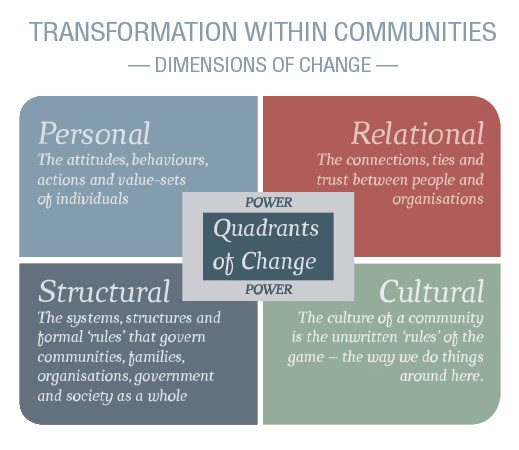




The Quadrants of Change Framework
To achieve sustainable change in communities, there are four key dimensions of change to consider.
To achieve sustainable change in communities, there are four key dimensions of change to consider: personal, relational, structural and cultural. Any successful and lasting community-change work needs to tap into each area over the course of the change process. Power is another element that has a significant impact on this process, as it influences what and how things happen in communities. This sits at the centre of the diagram and interacts with all other areas.

Diagram adapted from “Reflective Peacebuilding: A Planning, Monitoring, and Learning Toolkit” by J.P. Lederach, R. Neufeldt and H. Culbertson (2007)
One-off or smaller gradual changes may, over time, create the conditions for significant change in communities. What we think of as the ‘little things’ we do are often actually the seeds of ‘big things’ changing. However, it’s important to note that, in isolation, these one-off changes do not create stronger, more resilient communities. Each dimension of change needs to be considered and included. So this framework is really useful in helping us think about what else might need our attention and who in our communities and networks can focus on which bits.
Here are six questions to help you get started using this framework:
- To achieve the transformation you want in your community, what would change look like in each of the four quadrants?
- In which of the four quadrants do you focus most of your energy at the moment?
- Which is the hardest quadrant to work with at the moment, and why?
- Ideally, where do you need to focus your energy in the medium term to achieve the transformation you want?
- How can you model the change you want to see in your community in how you work?
- Who or what other resources could you access to help you with this work?
If you’d like to dig deeper into the Quadrants of Change framework, here’s a reflective inquiry tool that will help. The Leadership as Learning framework below offers more reflective questions about each of these four dimensions of change, to help you consider what needs attention in your CLD mahi.
